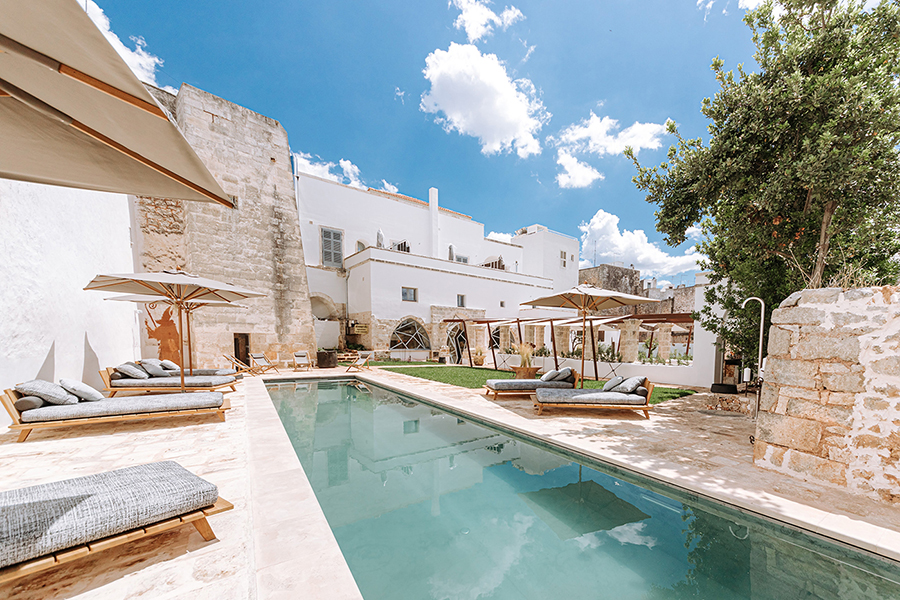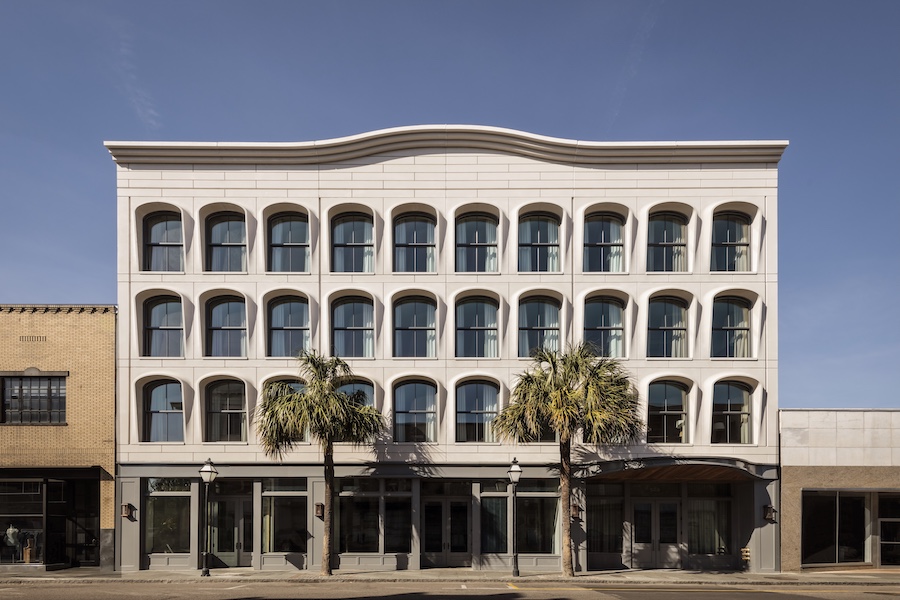Palace Intrigue is the Result of a Three-Year Revamp
A centuries-old structure on Italy’s southern coast stands out thanks to a thoughtful, thorough restoration
Words by: Alicia Hoisington

The recent restoration of the Paragon 700 Boutique Hotel & Spa, located in the heart of Ostuni, Puglia’s White City, was meant to be. Designers Pascale Lauber and Ulrike Bauschke, owners of Switzerland-based ID Living, had no intention of taking on a project in Italy’s Apulia region when they went to visit for a little R&R. Yet they found themselves taken with the 17th century red palace right when they saw it. “We were immediately drawn to the potential of the centuries-old gem,” says Lauber. “It was unthinkable not to make it a hotel; it really is just too beautiful to stay hidden.”
The three-year revamp, which touched every inch of the former Italian palace, home of the city’s first mayor (and other iterations), brought the building back to life through traditional handcrafted techniques with a splash of modern flair. For instance, tribute is paid to Pompeii Red, which became a fashionable status symbol in the 18th century as the pigment was the most expensive on the market. Cladding an entire façade in the red shade was a display of wealth at the time, standing out among the whitewashed buildings picturesque Ostuni is known for.
New surprises that became wowing design elements were uncovered almost daily. Significant discoveries included fireplaces, stone vaults, and frescoes such as Jesus and the Samaritan dating back to the 1700s. Several smaller details and treasures found renewed life, like a wooden door with peepholes typical of 17th century cloisters, suggesting the structure once housed a convent.
As exciting as it was to blend the old with the new, the building’s age also gave way to some challenges. “We had to restore and consolidate the entire roof, which meant removing every single tile by hand, and then replace each one just as carefully,” Bauschke says. Additionally, each of the hotel’s 11 guestrooms, named after gemstones, is completely different, and all are filled with equally unique pieces that the duo sourced from antique fairs, shops, and markets. “We don’t tend to search for items to fit somewhere specific, but they eventually find a home,” Bauschke says of items like South African sofas and headboards, a fire bowl-turned bathtub from India, and paintings by artists spanning the globe. “The main inspiration was to create exquisite design in every detail with beautiful energy while also preserving and celebrating the history of the building.”
Located in a centuries-old vaulted stone room, Restaurant 700 opens onto a traditional oil mill, now transformed into a convivial table and kitchen. Beyond the terrace sit the swimming pool and garden, complete with herbs and an orange grove. The hotel’s Bar 700 and the lounge is centered around its nearly 30-foot-long stone counter covered in antique Argentinian tin plates. Here, designers used muted colors and soft elements to encourage guests to stay awhile.
Nestled 23 feet underground lives the property’s spa. The ancient water cistern has found a new life as a luxurious escape with a hydromassage basin, steam bath, spa shower with
chromotherapy, and a relaxing lounge with Himalayan salt walls.
“We wanted to create something that didn’t already exist, a
hotel that is truly a one-off and that offers well-traveled guests an authentic Puglian experience,” Lauber adds. “A home away from home, if you will.”
Photos by Katja Brinkmann and Gregory Venere
Projects:
Palace Intrigue is the Result of a Three-Year Revamp
A centuries-old structure on Italy’s southern coast stands out thanks to a thoughtful, thorough restoration
The recent restoration of the Paragon 700 Boutique Hotel & Spa, located in the heart of Ostuni, Puglia’s White City, was meant to be. Designers Pascale Lauber and Ulrike Bauschke, owners of Switzerland-based ID Living, had no intention of taking on a project in Italy’s Apulia region when they went to visit for a little R&R. Yet they found themselves taken with the 17th century red palace right when they saw it. “We were immediately drawn to the potential of the centuries-old gem,” says Lauber. “It was unthinkable not to make it a hotel; it really is just too beautiful to stay hidden.”
The three-year revamp, which touched every inch of the former Italian palace, home of the city’s first mayor (and other iterations), brought the building back to life through traditional handcrafted techniques with a splash of modern flair. For instance, tribute is paid to Pompeii Red, which became a fashionable status symbol in the 18th century as the pigment was the most expensive on the market. Cladding an entire façade in the red shade was a display of wealth at the time, standing out among the whitewashed buildings picturesque Ostuni is known for.
New surprises that became wowing design elements were uncovered almost daily. Significant discoveries included fireplaces, stone vaults, and frescoes such as Jesus and the Samaritan dating back to the 1700s. Several smaller details and treasures found renewed life, like a wooden door with peepholes typical of 17th century cloisters, suggesting the structure once housed a convent.
As exciting as it was to blend the old with the new, the building’s age also gave way to some challenges. “We had to restore and consolidate the entire roof, which meant removing every single tile by hand, and then replace each one just as carefully,” Bauschke says. Additionally, each of the hotel’s 11 guestrooms, named after gemstones, is completely different, and all are filled with equally unique pieces that the duo sourced from antique fairs, shops, and markets. “We don’t tend to search for items to fit somewhere specific, but they eventually find a home,” Bauschke says of items like South African sofas and headboards, a fire bowl-turned bathtub from India, and paintings by artists spanning the globe. “The main inspiration was to create exquisite design in every detail with beautiful energy while also preserving and celebrating the history of the building.”
Located in a centuries-old vaulted stone room, Restaurant 700 opens onto a traditional oil mill, now transformed into a convivial table and kitchen. Beyond the terrace sit the swimming pool and garden, complete with herbs and an orange grove. The hotel’s Bar 700 and the lounge is centered around its nearly 30-foot-long stone counter covered in antique Argentinian tin plates. Here, designers used muted colors and soft elements to encourage guests to stay awhile.
Nestled 23 feet underground lives the property’s spa. The ancient water cistern has found a new life as a luxurious escape with a hydromassage basin, steam bath, spa shower with
chromotherapy, and a relaxing lounge with Himalayan salt walls.
“We wanted to create something that didn’t already exist, a
hotel that is truly a one-off and that offers well-traveled guests an authentic Puglian experience,” Lauber adds. “A home away from home, if you will.”
Photos by Katja Brinkmann and Gregory Venere


